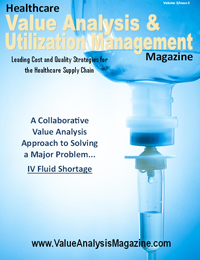Robert T. Yokl, President/CEO, SVAH Solutions
This teaming of America of the late 20th Century and now in the 21st Century becomes even more important as it relates to the evaluation, purchasing, and monitoring of the products, services, and technologies your healthcare organization is buying. No one person ever sees the negative or positive effects of how a product, service, or technology is impacting its internal and external customers. Yet, billions of dollars of products, services, and technologies are purchased by healthcare organizations annually that are controlled by a few individuals, many times with a narrow vision.
A better cost management system to manage and control the purchasing process (from acquisition to disposition) is for your healthcare organization‘s CEO to appoint a value analysis steering committee (VASC) for this purpose. In doing so, value analysis teams can be deployed by the VASC to involve all internal and external customers, stakeholders, and experts in the buying decision and subject all purchases to rigorous value analysis tests to determine the most appropriate products, services, or technologies based on functional requirements to meet customers’ wants and desires at the lowest possible cost.
Value analysis teams have unique characteristics to enable them to be effective in their sphere of influence. They must be in alignment with a healthcare organization’s compensation policies and also its culture, and they will need to develop creative strategies to align themselves with your healthcare organization’s goals and objectives. The best approach that we have found in the deployment of the value analysis methodology is a new team model, specifically designed for value analysis, which we call the Team-Based Project Management Model™ (TBPM).
Team-Based Project Management Model for Healthcare Value Analysis Teams
There are many different types of teams (parallel, process, time-based, and hybrid) according to Steven Gross, Principal, with William M. Mercer Consultants, functioning in the marketplace today. All of these teams are formed for different purposes within an organization. A parallel team is a part-time team whose members have two jobs and two bosses. One job is the one they were hired for and get paid for, in which they report to a supervisor. They also hold a cross-functional team position which they were appointed to and where they report to a team leader. These teams are temporary in nature and are established to solve specific problems that have arisen in their work environment in a matter of weeks or months, such as quality control issues, lost sales, etc. A process team is a full-time team that performs many functions across many boundaries to maximize productivity and customer satisfaction, such as an insurance claim processing team, customer service team, or a sales team. In some cases, a process team is self-managed and given the authority to hire, fire, promote, change, and implement new policies and procedures in their team environment. A time-based team is a team that is established with a specific purpose and time frame in mind to accomplish a specific task, such as designing a new computer system, accounting system, a new product line, or re-engineering a process or system. It can be either a full-time or part-time team position depending on the time requirements and urgency of the project. The emphasis is on speed to gain competitive advantage. A hybrid team is a combination of the characteristics of a parallel, process, and time-based team.
A Team-Based Project Management Team™ is a hybrid team having many of the characteristics of a parallel, process, and time-based team, but having some of its own unique attributes. It is designed specifically for use as the vehicle to plan, organize, support, control, investigate, study, and implement value analysis and value engineering savings and quality improvement opportunities in a healthcare organization.
Team Members are Project Managers, Too!
Traditionally, teams consist of team members who work collaboratively and are selected because of their specific skills and knowledge or are process owners that work together on an assigned project, whereas historically, project managers are assigned, from conception to completion, to manage projects as sole practitioners. A blending of a team and project management model is the foundation of the Team-Based Project Management Model™. Team members morph into project managers as their team leader assigns them value analysis studies, which they are responsible for conceiving, defining, planning, implementing, and evaluating. They are concurrently team members responsible for adding value to projects by reviewing all project managers’ reports and findings for reasonableness and completeness. They are also responsible for giving final approval, prior to implementation, of all value analysis studies performed by other project managers. The advantage of the Team-Based Project Management Model™ over other team models is that the TBPM model is greatly enhanced by combining the synergism of team members’ skills and knowledge with the disciplined approach of project management. This ensures accountability, customer focus, and a scientific approach to lower cost alternatives and quality improvements that get it right the first time.
Value Analysis Projects are Process and Time Based in Nature
TBPM teams are in many respects a process team since they meet twice a month and conduct value analysis studies on a part-time basis. They are also a time-based team in that they are established with a specific purpose (management and control of non-salary expenses) and have a time frame of 90 days to complete their studies.
All of the above characteristics make the Team-Based Project Management Model™ unique, yet similar to many of the teams that you have been members of in your working career. The big difference is that the TBPM model is specifically designed as a continuous process to manage and control non-salary expenses in a healthcare organization. This sets it apart from other parallel, process, or time-based teams that have other charges and goals in forming and performing their given tasks and responsibilities.
Decisions are Made by Consensus
One of the strengths of TBPM value analysis teams is that they make decisions by consensus, which enables the best ideas of project managers and team members to be filtered so that ill-conceived value solutions can be eliminated before they are proposed to a customer. This decision-making or filtering process ensures that the right product, service, or technology is recommended to customers with a high reliability factor that the lower cost solution will work the first time.
Get More Value Analysis Work Done In Less Time with Better Results
The whole purpose of the TBPM is to help your value analysis teams to get more value analysis work done in less time with better results. It also holds one person responsible for each new product, service, or technology evaluation or retrospective study. This ensures that your value analysis projects are accomplished on time, on budget, and are utilizing your defined value analysis process. This TBPM methodology is preferred by all value analysis teams that have embraced it as the only way they do business. The alternative is to continue to employ traditional VA team models that actually slow down, impede, and distort your value analysis process.
| About Robert T. Yokl, Founder & Chief Value Strategist for SVAH Solutions |
|---|
| Robert T. Yokl is President and Chief Value Strategist at SVAH Solutions. He has four decades of experience as a healthcare supply chain manager and consultant, and also is the co-creator of the Clinitrack Value Analysis Software and Utilizer Clinical Utilization Management Dashboard that moves beyond price for even deeper and broader clinical supply utilization savings. Yokl is a member of Bellwether League’s Bellwether Class of 2018. https://www.SVAH-Solutions.com https://www.SavingsValidator.com |
Articles you may like:
What is the Future of Healthcare Value Analysis and the Potential Moving Forward?





